14 Health Benefits of Vrikshasana and How to Do It?
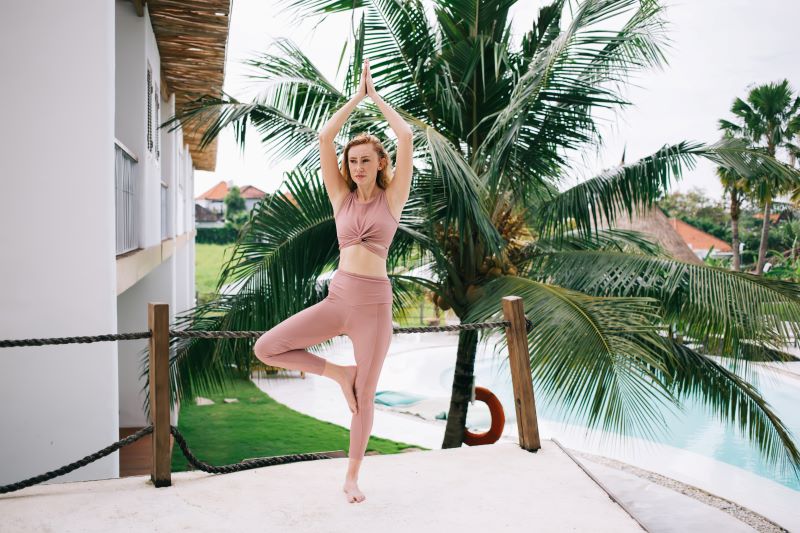
The name Vrikshasana is a combination of two terms; "vriksha", which means tree, and "asana", which stands for posture. Hence, it is commonly called the tree pose. Vrikshasana is one of the most basic yoga poses you can perform to improve your health.
If you are searching for “health benefits of Vrikshasana,” you are in the right place. Keep reading this blog to find other related information on tree pose.

Table of Contents

What is Vrikshasana?
Vrikshasana, commonly called the tree pose, is a foundational yoga pose for balance and strength. If you look at the stances ancient Hindu sages used to take, you will find their postures similar to Vrikshasana. This helps you understand the source of inheritance. Some ancient scriptures state that this is the posture used as a method of attaining austerity.
The right way to perform this yoga is to stand upright with one leg bent sideways at a right angle. At first glance, this may seem like an effortless yoga pose. However, standing correctly and holding the balance can be challenging for beginners. This yoga asana will help enhance overall posture and concentration and strengthen core muscles. This tree pose will help you rise in life like a tree does.
How to Perform Vrikshasana (Tree Pose)?
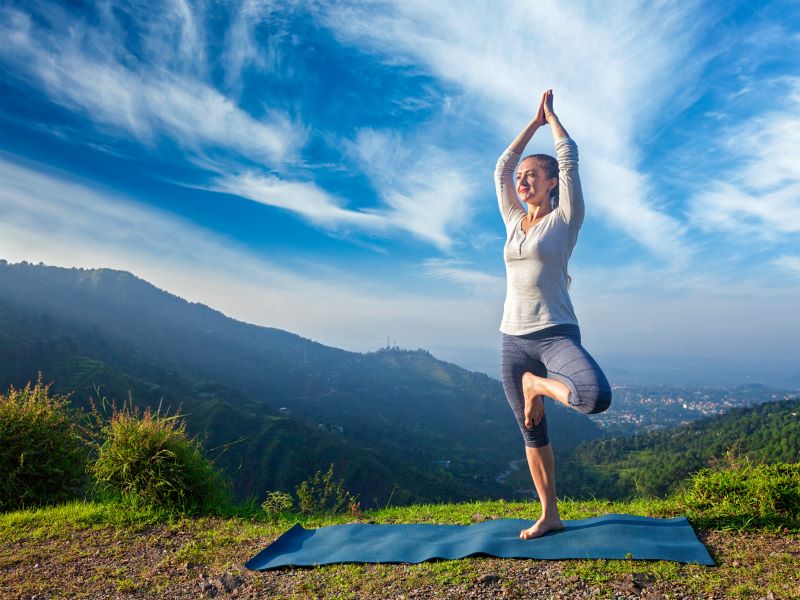
If you are a beginner, here are the steps to follow to do the tree pose in the right manner:
Step 1: Stand straight without slouching forward.
Step 2: Lift your right leg and balance it on the left thigh.
Step 3: Fix your feet in a way to make sure your legs do not slip away.
Step 4: Join your hands in a prayer gesture; stretch and raise them above your head.
Step 5: Stay in this position for as long as you can. You should continue breathing at normal intervals while doing this asana.
Step 6: Look straight and locate an object to focus and balance.
Step 7: When releasing from this pose, lower your hands to chest level. Then, slowly separate the palms and put your legs down.
Step 8: Repeat the same with your left leg after resting.
14 Health Benefits of Vrikshasana (Tree Pose)
Practising yoga regularly promotes good health and offers innumerable benefits. Here are some of the popularly known advantages of doing the tree pose.
1. Boosts Balance
Vrikshasana is primarily done to balance your body and mind. Therefore, you need to maintain a steady stance to attain this posture. Furthermore, once you successfully stand still in this tree pose, you must eliminate all unnecessary thoughts.
In short, you must concentrate on the position. Your body will then become calmer and more stable.
2. Tones Leg Muscles
One of the biggest benefits of Vrikshasana is that it tones the leg muscles. Practising the tree pose can help build muscles from feet to thighs. This mainly happens because you are using one leg at a time. It also makes your legs stronger and boosts flexibility.
3. Stabilises the Hips
Bearing the weight of one leg each time ensures the strengthening of the hip and pelvic bones. You should also know that by doing the tree pose, your hips open up and promote flexibility and strength in that area. In addition, this yoga is good for ovarian and uterine health.
4. Build Focus
This stance is the same as ancient sages used to attain peace or enlightenment, and there is a reason behind it. It is probably because Vrikshasana creates a sense of balance in mind and body. Therefore, doing this exercise and your routine exercises will stabilize the nervous system and ensure its optimum performance.
5. Improves Posture
To do this exercise, you must stand upright with a straight back. Thus, Vrikshasana creates a positive impact on the spine. This is one of the easiest and most natural ways to correct your posture. Furthermore, you are developing strength in both legs. So, now you do not have to suffer from the pain of putting all your weight on one leg.
6. Relieves Cases of Sciatica
Reducing sciatica's risks is also among the many health benefits of Vrikshasana. This is a painful condition that radiates from the sciatic nerve. It can result from many events, such as a sedentary lifestyle, slip-disc injury, sleeping on an uneven mattress, etc. The discomfort caused can be disabling; this is why experts suggest including the tree poses with your regular physical movements.
7. Strengthens the Ligaments
You also strengthen the ligaments as you tone the calves' muscles while doing the Vrikshasana. This can be painful in the beginning, but as you manage to balance properly, it will be very relaxing.
8. Encourages Mindfulness
In the practice of Vrikshasana, one must remain aware of the present moment to encourage mindfulness and note body, breath, and mind. This mindfulness can go beyond the yoga mat and enhance overall health.
9. Better Lung Capacity
Deep breathing within Vrikshasana enlarges the chest and ribcage, thus increasing the amount of air that can be inhaled during respiration. Increasing lung capacity helps to improve overall cell health and promote liveliness.
10. Improved Blood Circulation
The balance and stretch involved in Vrikshasana can boost blood flow throughout the body, supplying cells and tissues with more oxygen and nutrients. Improved blood circulation decreases pain and increases healing.
11. Ankle Strength Development
Vrikshasana entails standing on one leg, thereby strengthening ankle muscles. This eventually helps stabilise ankles, preventing future sprains or twists. With prolonged practice, you can expect reduced pressure on ankle joints.
12. Instills Confidence
Accomplishing a successful standing pose like this provides a lot of self-esteem due to the need for concentration, vital body parts, or even stable postures. Vrikshasana can help you feel better as you accomplish new yoga pose variations.
13. Widened Hip Mobility
By widening hip areas, such as opening up the hips by stretching the inner thighs, Vrikshasana enhances the hip’s mobility and flexibility, which is important for general body immovability and protection from injuries.
14. Stimulates Abdominal Organs
The gentle compression of the abdomen in Vrikshasana stimulates the digestive organs, improving digestion and helping to relieve digestive issues like constipation. It can also help reduce bloating issues and dysmenorrhea.
The Mudras of Vrikshasana (Tree Pose)
Struggling to keep balance and incorporating the mudras in Vrikshasana can truly bring the body, mind, and spirit into the union. This can deepen the practice, give one a new understanding, and reveal the secrets of existence hidden in this posture.
1. Anjali Mudra
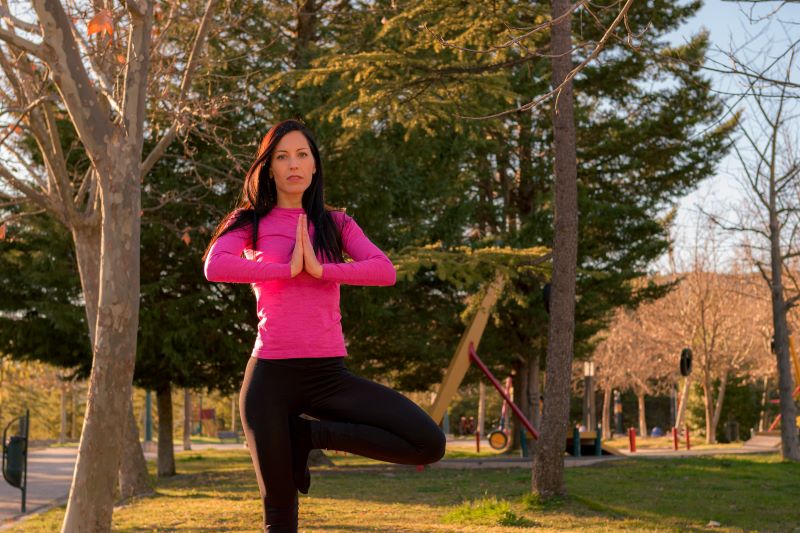
To perform this mudra, press your palms together at the centre of your chest. Your fingertips should point upwards. Breathe slowly in this position with your hands pressed lightly to your sternum. Stand firmly in the Vrikshasana pose and balance your core. This pose symbolises the union of the finest opposite halves.
Benefits of Anjali Mudra: Through this mudra, one can generate an intrinsic feeling of thankfulness, stability, and calmness, eventually leading to solid meditation and the ability to control the mind.
2. Gyan Mudra
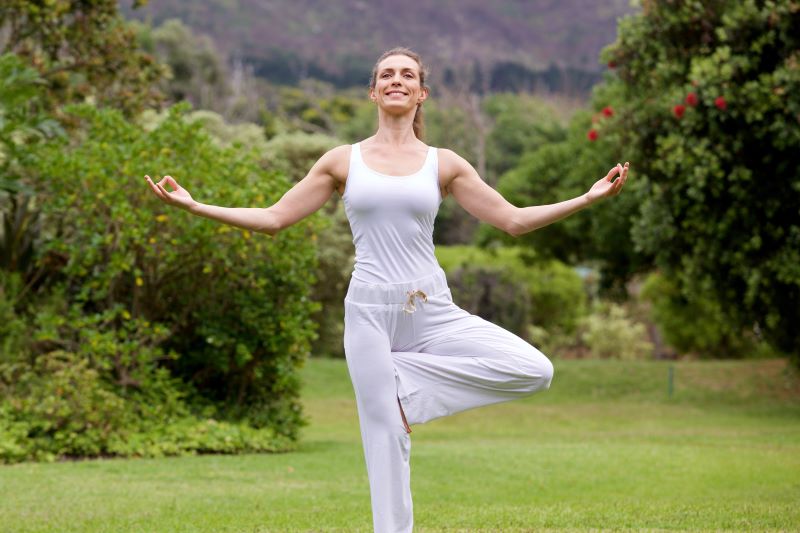
Another frequently used mudra is the Gyan Mudra, in which the end of the thumb touches the end of the stiff index finger, forming a circle, while the other three fingers are extended. Stand in Vrikshasana pose and perform this mudra for wisdom and inner peace.
Benefits of Gyan Mudra: It evokes renewed sympathy and connectivity towards the God within as one tries to maintain balance in a hand-to-foot pose.
3. Urdhva Hastasana
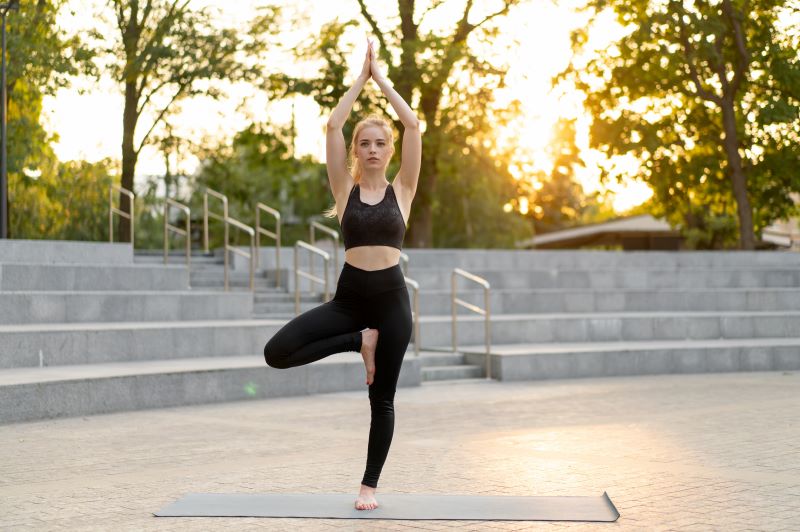
In Vrikshasana, balance on one leg and raise your arms overhead with palms together. Maintain a straight spine and engaged core for stability.
Benefits of Urdhva Hastasana: It improves balance in your body and enhances core muscles while regulating breathing and concentration.
Types of Vrikshasana (Tree Pose)
There are four types of Vrikshasana based on your comfort and expertise. Below are the four types:
1. Bending Tree Pose (Vrikshasana)
Stand straight with your feet together. Shift your weight to your right foot, bend your left knee, and hold your left ankle with your left hand. Place your left foot against your inner right thigh. Lift both arms above your head as you breathe in. Lean to the left with your right arm touching your knee and the other arm still raised till you've tilted to the left.
2. Half-Lotus Tree Pose (Ardha Padmasana in Vrikshasana)
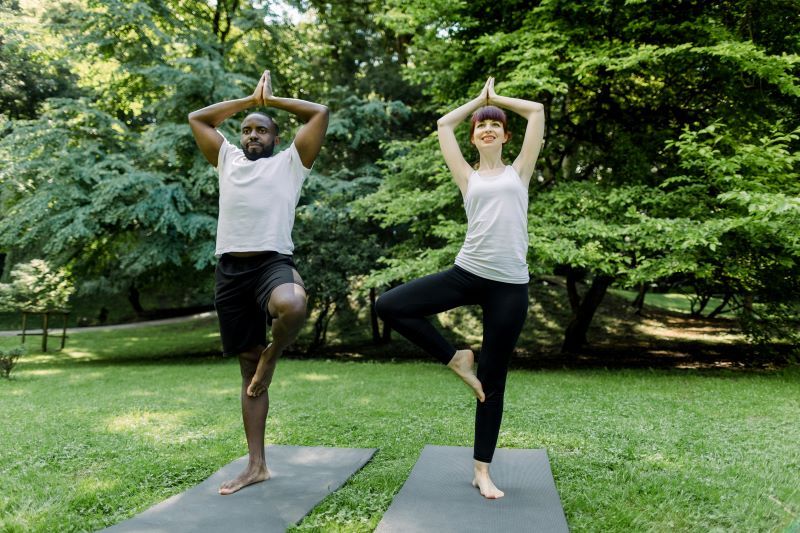
Stand tall with your arms down at your sides. Shift your weight onto your right foot. Slowly lift your left knee towards your chest. Place your left heel as high as possible on the front of your right thigh or hip. Make sure your left sole lines up with your right knee. Focus on one spot on the floor about four feet before you. Hold this position and breathe for about a minute.
3. Side Plank Pose (Vrikshasana in Vasisthasana)
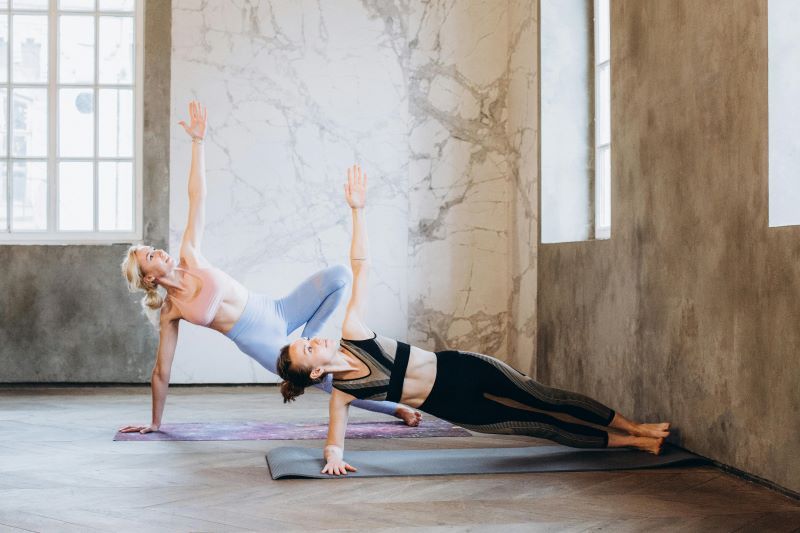
Start in the sideways plank position with your shoulders over your wrists. Stack your left foot on top of your right foot. Lift your top leg like you're doing a tree pose, and place the sole of your left foot on the inside of your upper right thigh. Lift your left arm and turn to face upward. Keep your right leg straight and pull your right shoulder blade back to open your chest. Take up to ten breaths in this position.
4. Handstand (Vriksasana in Adho Mukha Vrikshasana)
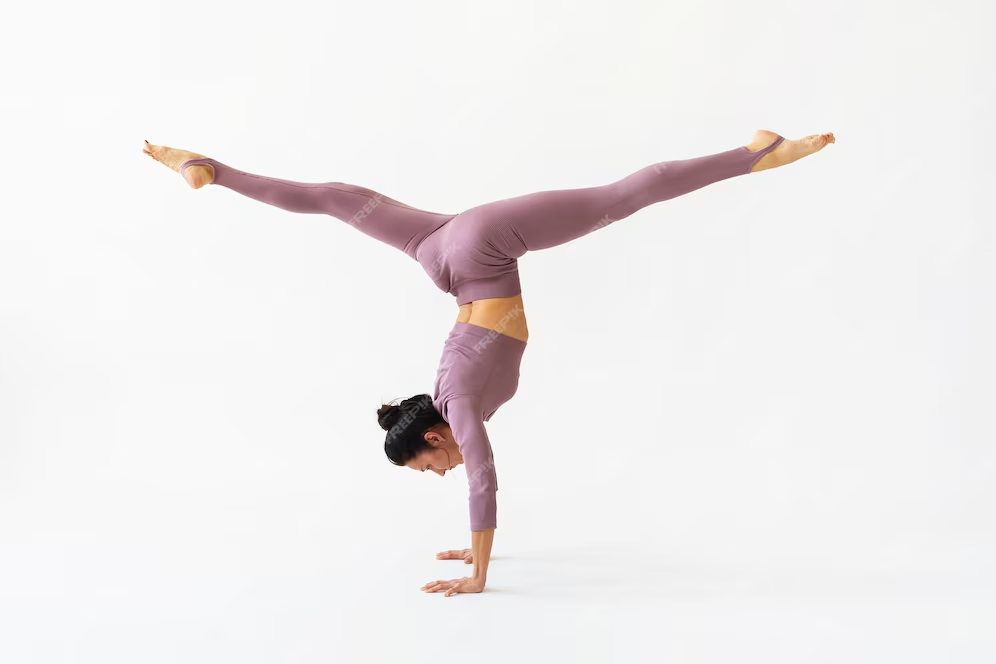
Start in a downward-facing dog position. Step your feet halfway in, keeping your hands on the ground and your shoulders over your wrists. Keep your right leg straight, bend your left knee slightly, and push the ground away to lift yourself. Use the balls of your feet to press upward. Try to place your left foot on the thigh of the right leg by bending your left knee.
Things to Know Before Doing Vrikshasana
Before beginning your Vrikshasana, remember a few important points to ensure you get the best out of the pose. Here are some key points to consider before doing Vrikshasana in yoga:
- Warm-Up: Begin with a gentle warm-up to prepare your body for the pose. This can include basic stretches for the legs, hips, and spine to loosen up the muscles and joints.
- Stable Surface: Practice Vrikshasana on a stable, level surface to ensure balance and stability. Avoid slippery or uneven surfaces that could cause you to slip or lose your balance.
- Focus on Alignment: Pay attention to proper alignment throughout the pose. Place the foot of the standing leg firmly on the floor, engage the core muscles to support the spine, and keep the shoulders relaxed.
- Start Slowly: If you're new to Vrikshasana, start with a modified version of the pose by placing the foot of the lifted leg on the calf instead of the inner thigh. As you gain strength and balance, you can gradually work your way up to the full expression of the pose.
- Breath Awareness: Maintain steady and controlled breathing throughout the pose. Focus on inhaling and exhaling deeply to help calm the mind and maintain concentration.
- Use Props if Needed: If you struggle to balance in Vrikshasana, use props such as a wall or chair for support. You can place your hand lightly on the wall or hold onto the back of a chair to help stabilise yourself as you work on the pose.
- Listen to Your Body: Pay attention to how your body feels in the pose and modify as needed to avoid strain or discomfort. If you experience any pain, especially in the knees or lower back, come out of the pose immediately and consult with a qualified yoga instructor or healthcare professional.
- Mindfulness: Practise Vrikshasana with mindfulness and awareness. Focus on the present moment, observing bodily sensations, thoughts, and emotions without judgment.
By following these guidelines, you can safely and effectively practice Vrikshasana to improve balance, strength, and concentration in your yoga practice.
How Long to Sit in Vrikshasana?
According to the person’s own flexibility, comfortableness, and experience level, the period an individual can be at ease in the Vrikshasana varies:
- For Beginners: Aim to keep your sessions between 15 and 30 seconds before changing sides. Do not push yourself too much.
- For Intermediates: Intermediates can hold the position for 30-60 seconds before changing sides.
- For Advanced Practitioners: The Vrikshasana may be held comfortably for 1-2 minutes or more per side.
Risks of Overdoing Vrikshasana
Vrikshasana has many benefits, and you can reap them with regular practice. However, there are a few risks involved in an unmonitored practice of a yoga pose. Careful practice ensures your safety and comfort.
The following are a few risks if one overdoes Vrikshasana (Tree Pose):
- Muscle Strain: When stretched too much or sustained longer, muscle straining may be particularly noticeable in the standing leg, hips, and lower back due to their natural state. This discomfort can sometimes lead to injuries.
- Joint Strain: Overdoing knee pressure on standing legs might sometimes create tension, thus causing shock and even injury, especially when the wrong wobble or knee issues may exist.
- Balance Issues: In Vrikshasana, attempting to push too much beyond your limit may cause imbalance, causing one to fall or land uncomfortably, resulting in twisted ankles or injury.
- Overuse Injury: Over-engaging in Vrikshasana without enough rest periods can cause tendonitis or stress fractures, which are common, especially in lower limbs.
- Spinal Misalignment: If maintained for a long time or without good posture, the back is strained, leading to discomfort or making existing ones worse.
- Blood Pressure Fluctuations: Vrikshasana postures allow changes in blood pressure to occur within the body. They can create variable levels of this compound; if taken too far, it may be problematic, especially for those with high blood pressure or any heart condition.
- Emotional Stress: Vrikshasana makes one want to reach their mark and feel not well if doing anything under the mark for women will hinder them from reaping the full benefits expected while taking this asana.
- Fatigue and Exhaustion: Overexertion in Vrikshasana may lead to fatigue and exhaustion depending on the activity.
To avoid these risks and gain the benefits safely, it is crucial to practice Vrikshasana thoughtfully so that you listen to what your body is saying while respecting its limits.
Important Tips for Practising Tree Pose
To benefit from any yoga, you must know the correct procedure for doing it. Furthermore, you can use these tips to extract additional benefits:
Make sure the hips do not move to either side.
Do not place your feet on the knee joint because it will leave you unstable.
Position your bent leg so that the knee points outward, which will help you remain still on one leg.
While you are placing the feet, avoid clenching. Otherwise, this will cause minor movements, and you will eventually lose balance.
Engage your calves, muscles, and glutes when practising Vrikshasana. This will help you retain balance and tone these muscles.
Relax and continue breathing normally. Try not to shift your focus from the stance, as doing so can cause you to lose balance.
What are the Precautions and Contraindications of Vrikshasana?
To successfully attain the benefits of this asana and avoid accidents while doing it, you need to know specific precautionary methods. These include:
You should avoid Vrikshasana if you are recovering from a leg, back, or knee injury.
If you find it hard to balance your feet above the knees, start by placing them below them. However, never place it on the joints because it will create an imbalance.
It is better to consult your healthcare provider if you have insomnia and high or low blood pressure.
Who Should Avoid Doing Vrikshasana?
Vrikshasana benefits people in many ways but can threaten those with the following issues. Here are a few points explaining who must keep away from doing Vrikshasana (Tree Pose):
- Recent Ankle, Knee, or Hip Damage: Individuals who have suffered from accidents to their ankles, knees, or hips these days must avoid Vrikshasana. This pose requires balance on one leg, which could result in more harm or prevent recovery.
- Chronic Balance Issues: Those with chronic stability troubles, such as vertigo or vestibular disorders, can also find it hard to maintain stability in Vrikshasana. Attempting this pose should increase the chance of falls and further damage.
- Uncontrolled High Blood Pressure: Holding the body in a standing position with one leg pressed against the other thigh moderately elevates blood pressure, so it is unsuitable for individuals with elevated blood pressure.
- Pregnancy: During their pregnancy, particularly in the second and third trimesters, women should avoid this pose because the balance and stability required in this stand may be affected by pregnancy.
- Conditions or Spinal Injuries: Individuals suffering from spinal injuries or conditions like herniated discs or sciatica should not try Vrikshasana. This pose involves a lot of spinal extension and balancing, which might worsen already-existing issues or cause new injuries.
- Headache or Migraine: In a situation of severe headache, one has to gaze and maintain balance while doing Vrikshasana, which does not help improve things for the worse when people have migraines or severe headaches.
- Recent Surgery: Individuals who have undergone surgery recently, especially in the lower limb, spinal cord, or abdomen operations, should not do Vrikshasana until they heal completely. Starting this pose too soon may interfere with the recovery processes and result in other problems.
- Joint Pain or Inflammation: People suffering from serious joint pain and inflammation in the ankles, knees, and hips should not practice Vrikshasana. Performing the pose means loading the affected joints with weight.
What are the Easy Modifications of a Tree Pose?
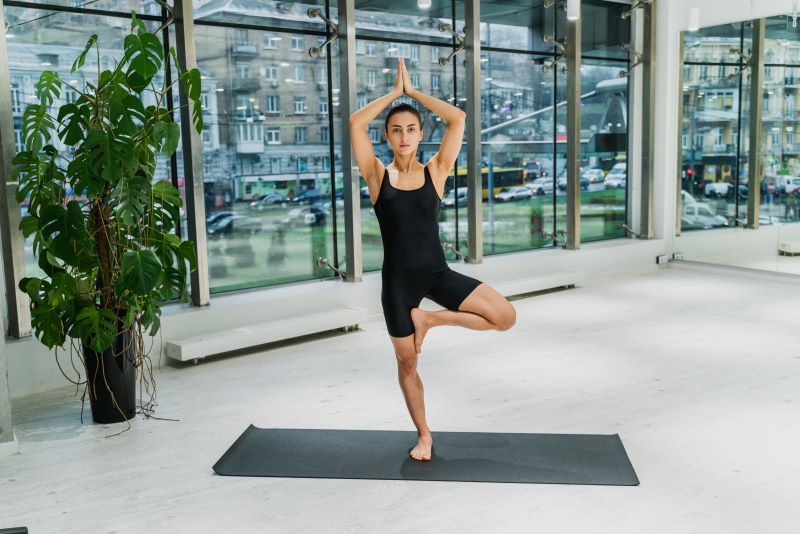
If it is difficult for you to balance, you can try these easier modifications to attain the correct tree pose finally:
- Lift the Heels: Stand straight, rotate your left leg, bend your knee and rest the left heel on your right inner shin. Join your hands in the praying gesture at chest level. Take deep breaths and hold for some time, then repeat with another leg.
- Reclined Bent-Leg Tree: Lie on your yoga mat, and pull your knee to your chest. Keep your right hand on the right hip to prevent you from rolling. While bending your left knee, place your left foot on your right thigh. You can use a block for extra support under your right knee. Take some deep breaths and then repeat with the other leg.
- Take Support of a Wall: Stand half an arm's distance from the wall. Now, with your right hand, take support of the wall. Then, shift your body weight to your right leg and place your left foot on the right thigh. Stay in this position for at least 10 seconds and repeat with the other leg.
Vrikshansa primarily improves your body balance and posture. Along with some health benefits, it also helps enhance concentration and patience and calms your mind. Vrikshasana may seem like a simple yoga posture, but it can be challenging if you do it for the first time. Nevertheless, start today if you want maximum benefits from this yoga.













